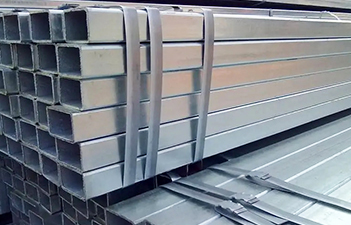FAQ
Process characteristics and application of galvanized square tube
Release time:2025-04-18
Galvanized square tube is a square section steel pipe that has undergone galvanizing treatment, combining the strength of the steel pipe with the anti-corrosion performance of the galvanized layer. It is widely used in fields such as construction, machinery, transportation, and agriculture.
1. Classification of galvanizing processes
Hot Dip Galvanizing
Immerse the square tube into molten zinc solution (about 450 ℃) to form a uniform layer of zinc iron alloy, typically with a thickness of 50-80 μ m.
Advantages: Strong corrosion resistance, long lifespan (up to 20-30 years), suitable for outdoor or humid environments.
Disadvantages: The surface is slightly rough and may have zinc nodules or residue.
Electrogalvanizing (cold galvanizing)
Deposition of zinc layer on the surface of square tube through electrolytic reaction, with a thin thickness (5-20 μ m)
Advantages: Smooth surface, high dimensional accuracy, and low cost.
Disadvantages: Weak anti-corrosion performance, mostly used indoors or in dry environments.
2. Main features
Corrosion and rust prevention: The zinc layer isolates air and moisture, extending its service life.
High strength: The square cross-section provides excellent bending and compression resistance.
Aesthetics: The silver white coating does not require additional coating, and some parts can be color coated.
Easy to process: can be welded, cut, and drilled, but attention should be paid to protecting the coating (such as zinc supplementation after welding).
3. Common specifications and materials
Material: Q235 (ordinary carbon steel), Q345 (low-alloy high-strength steel), etc.
Sectional dimensions: Side length ranging from 20 × 20mm to 400 × 400mm, with a wall thickness of 0.8-20mm.
Length: Usually 6 meters per piece, can also be customized.
Standards: Complies with GB/T 3091-2015 (China), ASTM A500 (USA), etc.
4. Application scenarios
Building structure: scaffolding, steel frame, roof support.
Transportation: guardrails, road signs, vehicle chassis components.
Mechanical manufacturing: equipment brackets, conveying pipelines, storage shelves.
Agriculture: greenhouse skeleton, irrigation system.
5. Precautions for purchasing
Environmental adaptation: Hot dip galvanizing is preferred for outdoor or corrosive environments; Electric galvanizing can be selected for indoor dry environments.
Zinc layer thickness: Select according to requirements (such as the minimum thickness of hot-dip galvanized layer specified in ASTM A123).
Surface quality: Check for defects such as missed plating, bubbles, scratches, etc.
Dimensional tolerance: Ensure accuracy that meets engineering requirements (such as diagonal deviation).



 English
English